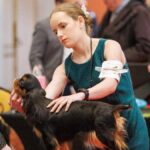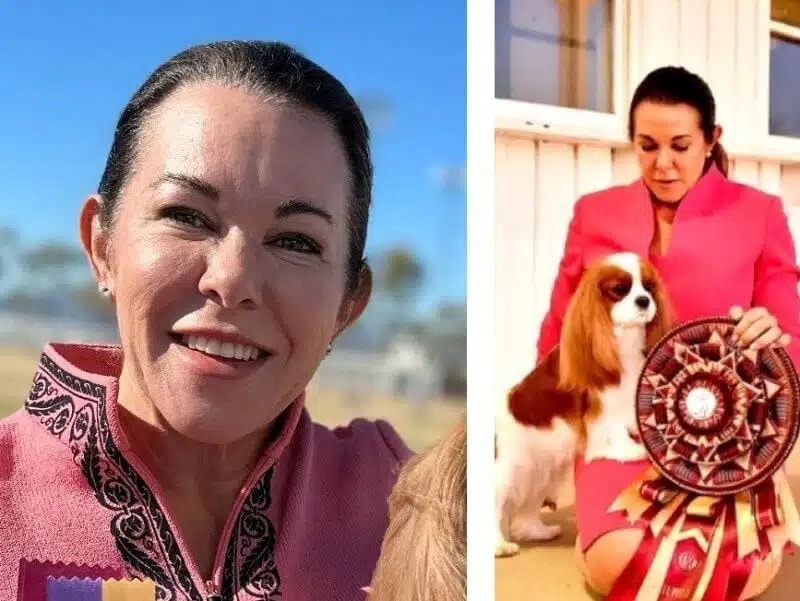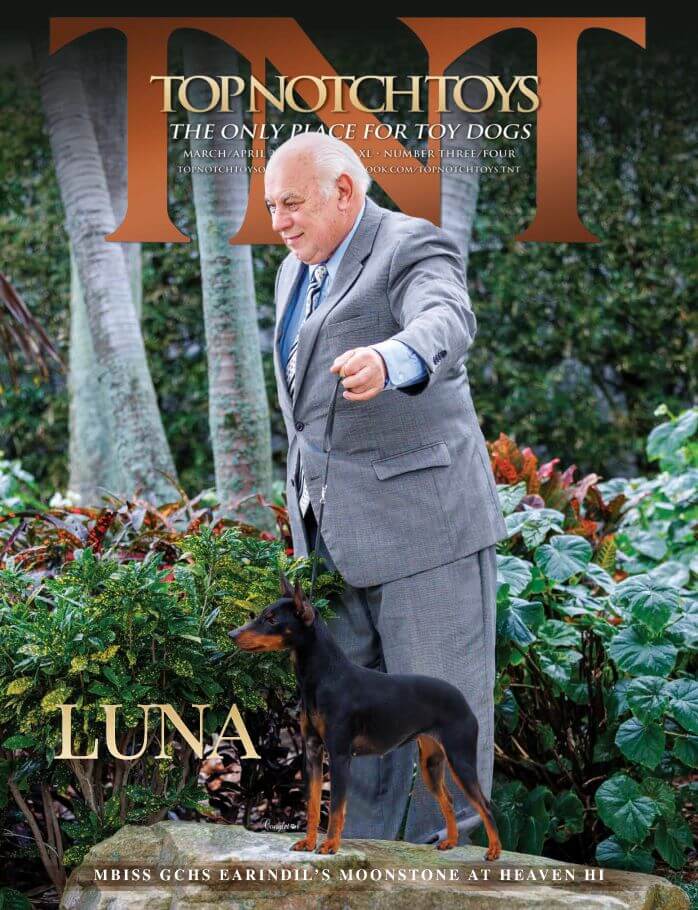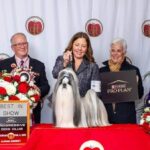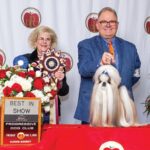Interview with Kelly Fadel, Breeder of CrownHeir Cavalier King Charles Spaniels
Where do I live? How many years in dogs? How many years as a breeder?
Kelly Fadel: Our family currently lives in Manhattan, New York, for the summer and we will return to Austin, Texas, in the fall.
When it comes to answering, “How long have I been involved in dogs,” I like to say, “I was whelped into a Samoyed litter.” In other words, I was born and bred into this world of AKC show dogs. My Mom showed and bred Samoyeds. Later, we added a couple of Australian Shepherds to the mix because they fit in well with horse shows. I spent most of my early childhood, and into college, showing the horses. My Mom mostly showed the dogs, and when I wasn’t showing horses I would assist her ringside and take back in her Winners while she showed a Special. That is pretty much how I remember my younger years; dogs shows and horse shows, but there were always dogs.
In 1994, I got married and my husband and I purchased my very own show dog, a Rottweiler bitch. That was the start of my own kennel apart from my Mom’s kennel. She is still my mentor and my support. Showing dogs and horses has always been a passion of mine and it remains so today. For me, breeding is secondary. I have bred an extremely limited number of litters; five, to be exact. From my personal dogs, I have finished 11 Champions to date.
From 1996-2009, I showed multiple breeds from the Working, Herding, Sporting, and Hound Groups for friends and clients and I never kept track of the number of Champions I finished. I loved, and still love, to start and finish young ones. To this day, my Mom expects a call after every show to give her a wrap up and tell her my ring times for the next day. She gets especially excited when she hears I am showing to judges she showed to in the early 1970s and ‘80s. I am truly grateful that she was my introduction and mentor in the world of show dogs and preservation breeders.
What is my kennel name? How many dogs do I currently keep?
Kelly Fadel: Having started out in Rottweilers in 1994, and living in Texas at the time, my husband and I chose Texadel as our kennel name. However, my husband spent years growing up in Virginia, and in 2000 we found ourselves back in the VA/DC area where we later started our family. Living on the East Coast and having the prefix Texadel sparked lots of conversation! So, when I purchased a Cavalier King Charles Spaniel to show in 2016 it seemed appropriate to come up with a kennel name that reflected our family’s beliefs and the breed’s heritage. As a result, I now register my dogs under the kennel name CrownHeir.
As for how many dogs I keep, 3-4 in my home is the limit. My Mom is available to help with my intact girls or boys that aren’t currently being shown but will be bred. My retired dogs go to live in a forever home. There are the matriarchs that are the exception to this rule. They stay with me until they cross the rainbow bridge. Keeping a small batch allows me to spend time with my family, travel, and do life outside of dogs. And, I still have the time to provide my dogs with one on one devotion, training, and the necessary conditioning it takes to be a success. Maybe someday I will have that adoring brood of 8-10 Cavaliers shadowing my every move, but for now, “four and no more.”
Which show dogs from the past have been my noteworthy winners?
Kelly Fadel: Generations worth of dogs, bitches, and kennels, both nationally and internationally, have contributed noteworthy breed specimens that have strengthened the standard and upheld our mission to breed healthier, structurally sound dogs with correct temperaments. It takes a village. I am especially grateful to all the breeders and kennels behind my dogs that dedicated themselves to breeding and proving dogs of noteworthiness. They have paved the road for the breed and breeders of today and tomorrow.
As for my past, which started 29 years ago with a hiatus from 2009-2016, I would have to say my personal noteworthy winners were all the dogs I finished from Bred-By. As a small breeder-handler, to produce and finish breed specimens with correct type and sound, fluid movement that also possess correct temperament and good health helps me to know I am fulfilling my responsibility to the breed.
Finishing dogs from the Bred-By Classes is the icing on the cake. A recent Bred-By noteworthy winner that I am currently showing is RBIS MBISS GCHB CH CrownHeir Hallelujah, “Halle.” In 2022, she was No. 1 CKCS Bitch All-Breed and wrapped up the year winning Breed at AKC Royal Canin. In 2023, Halle is still ranked No. 1 CKCS Bitch as of 5/31/23 in Breed and All-Breed. She is also No. 1 NOHS CKCS and Top 20 NOHS All-Breed as of 6/13/23.
Which have been my most influential sires and dams?
Kelly Fadel: That’s an easy question. When focusing on my Cavaliers, I have only had one bitch I bred so far and she produced a litter of three, which all three were Breeder/OH finished. Two of the three finished from Bred-By with the third unable to garner that title because she was pointed from the Puppy Classes just before they offered Bred-By Puppy. One was NOHS No 6 Cavalier for two years in a row with only one year of showing, and the other is Halle who is currently No. 1 CKCS Bitch. Halle and I will also campaign for Top 10 NOHS All-Breed and No. 1 CKCS NOHS.
Can I talk a bit about my facilities? Where are my puppies whelped? How are they raised?
Kelly Fadel: My Cavaliers are raised in our home. I am very fortunate to have a separate guest house, so I can groom in that space and raise the puppies out there so Mom can have quiet space for her and her babies. I sleep out there with them when the puppies are born for three straight weeks. In answering, “How are they raised?” I would say I allow Mom to do her job, but I am definitely a helicopter Mom when it comes to raising the babies and overseeing Momma. I am right there charting the entire progress and ensuring each baby is hydrated, warm, and happy.
What is my “process” for selecting Show Puppies? Performance Puppies?
Kelly Fadel: My process for evaluating show puppies starts with that “helicopter Mom” style of sub-parenting. I constantly watch the growth, changes, personalities, and health. I do a full puppy evaluation at eight weeks of age. After, I select my keeper(s) and run on them until they prove otherwise.
How important are Breed Specialties to me? How important are Group Shows?
Kelly Fadel: I love Specialties and Group Shows. These shows draw many breeders who tend to bring out their best breed specimens. It’s a great place to view and, hopefully, put hands on potential breeding stock. The only drawback to Specialties and Group Shows pertains to NOHS. We breeders and owners who participate in the program don’t have the opportunity to compete for BIS OH or RBIS OH, which takes away from the possible opportunity to gain additional points. This would be a great area for the program to take a closer look at some revisions. The camaraderie and overall enjoyment tend to be higher at these kinds of venues and it’s a great way to support your breed clubs.
What are my priorities when it comes to breeding? What are the drawbacks?
Kelly Fadel: My priority is selection of breeding stock. I evaluate pedigrees three generations back for phenotype and consider five generations when looking at coefficiency. Phenotype compatibility is my highest priority. I am also looking at the genetic tendencies of recessive genes when combining the two pedigrees. My goal is to breed a litter according to the Breed Standard with correct type and consistency throughout the entire litter. Knowing my pedigrees and knowing the strengths and weaknesses of the breeding pair help me to strive for soundness and quality.
The drawbacks are my lack of tenure in the breed; not having put my hands on these dogs of the past. I rely heavily on excellent mentors who have a long history in the breed, understand proper structure, and can evaluate breeding stock for compatibility in genotype and phenotype.
How would I define “conditioning” as it relates to my breed? How important is coat care?
Kelly Fadel: Conditioning, for me, would be methods of exercise dependent on age and structure of the dog. Natural, free-roaming space to run and play under the age of two is conditioning for me. Over two, I condition my Cavaliers on the treadmill and on natural sloping terrains. The Cavalier King Charles Spaniel (CKCS) is an active, graceful, free in action breed where our Standard calls for, in the Forequarters section, the “shoulders well laid back” and in our Hindquarters section states “…a good broad pelvis, moderately muscled; stifles well turned and hocks well let down.”
A dog correctly built in these areas of the Standard would require more conditioning to keep the movement fluid and free in action while building proper muscling to support those tendons and ligaments. If the dog were a straight-fronted, open-angled counterpart it would not be built for exercise, nor would it be as active and the movement would not be free in action. For the sake of longevity and the health of the dog, I would not advise treadmill work and simply allow that dog to run and play on its own accord.
Coat conditioning is very important to our breed. The elegant, royal appearance of the CKCS is enhanced by that gorgeous silky coat with long feathering on ears, chest, legs, and tail. The slippers are a feature of our breed. To maintain the look, regular baths, conditioning, and regular brushing are essential.
Are there any health-related concerns in my breed? Any special nutritional needs?
Kelly Fadel: The CKCS is no different than any other breed. We all have our health concerns. Our National breed club, American Cavalier King Charles Spaniel Club (ACKCSC), is doing an excellent job funding research grants and keeping members and the public aware of ongoing research projects in the areas of diseases that concern our breed. With any preservation-bred dog, we see lower rates of affliction than the backyard-bred or puppy mill-bred dogs. I feel the ACKCSC and its breeders are doing excellent work towards finding cures and breeding lower numbers of dogs afflicted with disease.
As for nutrition, each breeder has their own ideas of what nutrition looks like for them and their dogs. As for specific nutritional needs for a CKCS, I believe caloric intake is vital for the health of the organs, specifically the heart, along with proper omega-3 fatty acids.
Do I think my breed is supported by a sufficient number of preservation breeders?
Kelly Fadel: At the national level of showing, the guardians of the breed are a large group of excellent preservation breeders. As for a “sufficient number” in relation to the number of people who own and breed Cavaliers, I would be hesitant to say. I would love to see all people who are going to keep and breed intact males and females evaluate their breeding stock according to the Standard, and place ultimate value on the health and temperament of the breed so that all dogs are health tested and temperaments evaluated. Ultimately, eliminating poor specimens from the gene pool.
Is my breed well suited to be a family dog? Who are the best candidates to own my breed?
Kelly Fadel: The Cavalier is a loyal, active, fearless, and sporty dog. For the most part, a Cavalier makes an excellent family dog. It all depends on the family. The breed loves their people and most tend to want lots of attention. They don’t like being separated from their people.
Individuals or a family that are the best candidates are ones who have someone working from home, who doesn’t mind a lap dog and putting to use a lint roller, as well as one who is fairly active in the sense that they can take the dog for short walks or has a yard to allow them to run and get good exercise.
What is the biggest misconception about my breed? What is my breed’s best-kept secret?
Kelly Fadel: The Cavalier has grown to be a popular breed; therefore, I don’t believe there are too many misconceptions other than the fact that they don’t all die of heart disease. The best-kept secret has to be that they are really smart! Having come from Aussies and Rotties, I didn’t expect much in the way of intelligence but they proved me wrong. They are wickedly smart and adoring.
If I could share a comment or two with judges of my breed, what would I like to say to them? First, thank you, judges, for taking the time to study our breed and judge against our Standard, only rewarding specimens of excellent type; the highest honors.
A judge shared a recent discovery; after judging a show with quality specimens, the person realized that MODERATE didn’t mean “weedy” or “fine-boned” or “petite.” That judge is correct. The Cavalier is moderate, meaning nothing exaggerated; no hard edges, not over-sized or under-sized; no exaggerated angulations; and no brachycephalic-style heads, muzzles or stops. We are not a brachycephalic breed. Everything moderate and in balance.
The description of proper size, proportions, and substance are in the Standard. The paragraph uses the language “moderate” and specifically states to penalize weedy and coarse specimens. The Cavalier’s true elegance and royal appearance come from a sweet, gentle head with large, dark, round eyes and proper cushioning, an overall well-balanced body with well laid-back shoulders that flow into an elegant look with bone that’s moderate, and a broad pelvis with moderate muscling. This defines an elegant, graceful specimen that moves free in action. Please help the CKCS avoid the pitfalls of breeding extreme phenotypes that lead to disease-related issues. Again, I thank you for coming alongside us and helping us be guardians of the breed.
Do I have any words of wisdom to pass along to newer breeders?
Kelly Fadel: To anyone coming into any breed, study it first. Go to dog shows and sit ringside. Buy a catalog and follow along with the classes, playing judge by marking your favorite and then comparing it to how the judge placed the class. Develop an eye for what you like and start studying the Breed Standard. Once you find a style within the breed that you are particularly drawn to, figure out which bloodlines exhibit those looks and then contact the breeders of those lines. Upon getting to know that breeder, ensure it’s a relationship and connection that you can see yourself having for years to come because, once you take on a breeder’s baby, you are a part of their family.
For a bit of fun, what’s the most amusing thing I’ve ever experienced with a Toy Dog?
Kelly Fadel: Amusing… wow! They amuse me every single day. I have a hunter and she is my matriarch of the bunch. She is faster, smarter, and more patient than the kiddos. She catches lizards, geckos, and once, a squirrel! She held it very softly in her mouth and paraded it around, being very proud of herself, no doubt. The look she gave me when I told her to drop it. LOL. She seemed to say, “WHAT?!” However, being the awesome and obedient lady that she is, she gently set the squirrel down and off it went. I think the squirrel gained respect for her from that day forward and now plays outside the dog yard!
